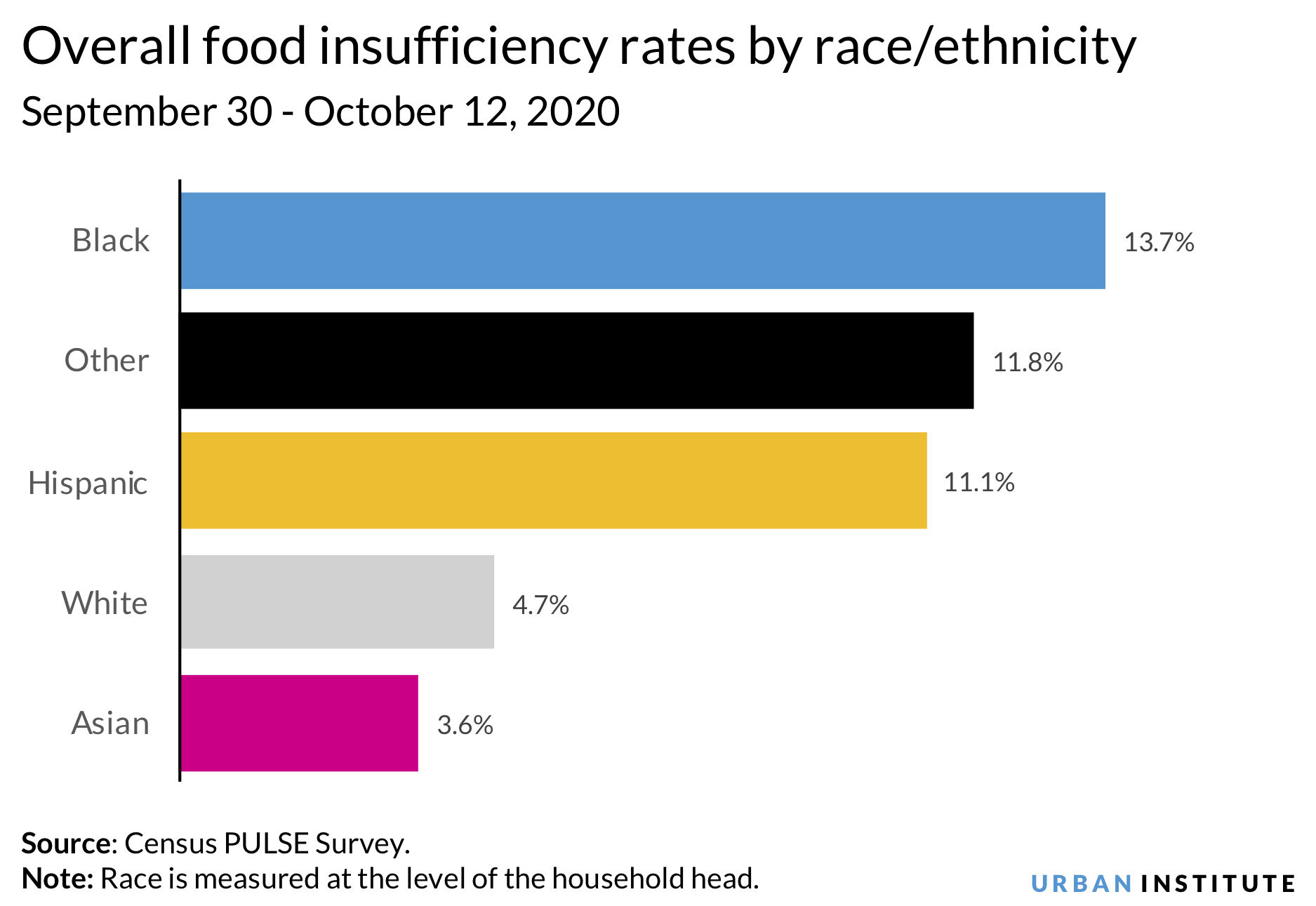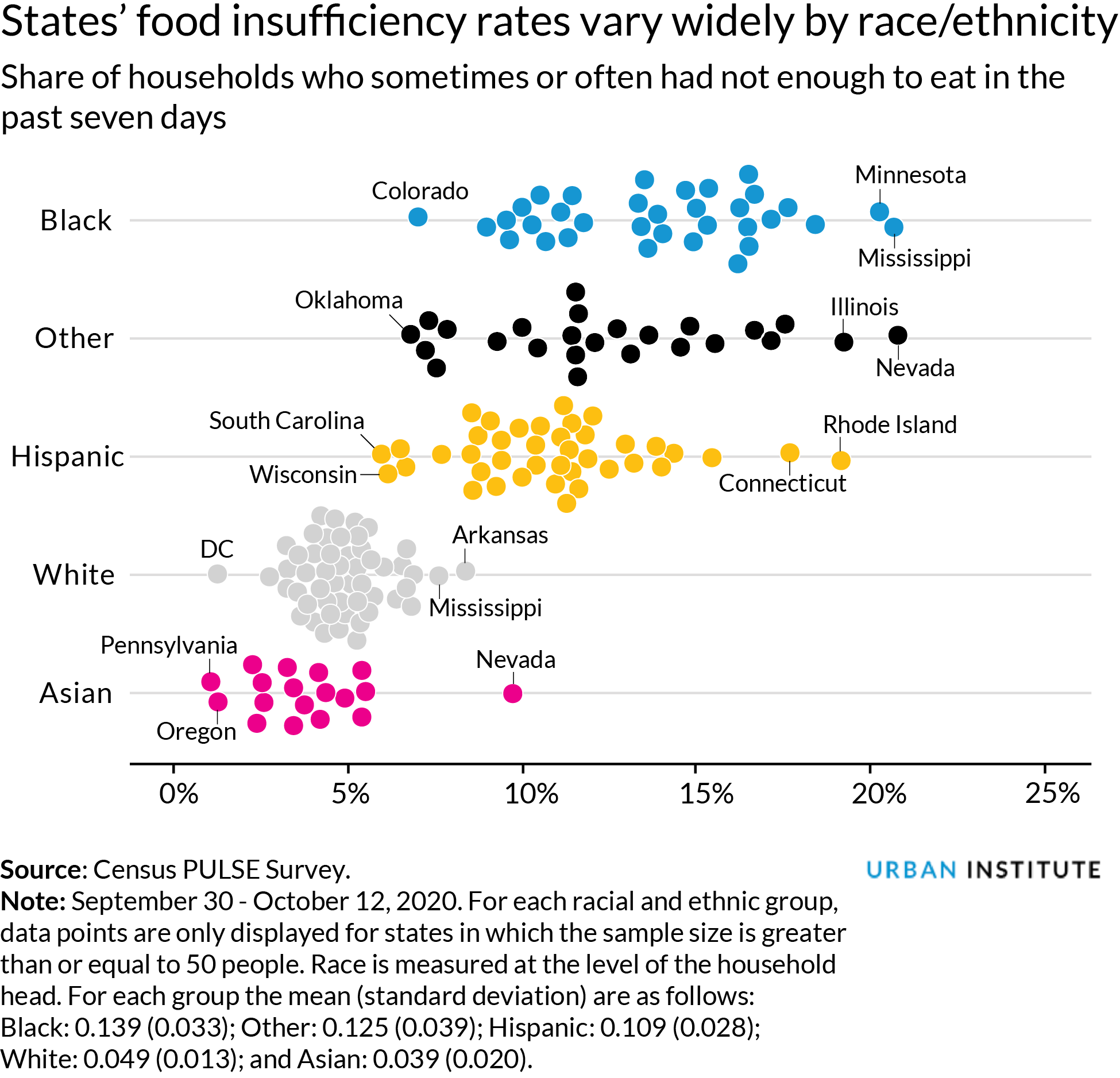
<p>Workers prepare bags with free produce during a pop-up food pantry event hosted by Food Bank For New York City at Barclays Center on September 10, 2020 in New York City. In addition to unemployment and homelessness, millions of Americans face food insecurity as a result of the economic downturn caused by the coronavirus pandemic. (Photo by Michael Loccisano/Getty Images for Food Bank For New York City)</p>
The COVID-19 pandemic has exacerbated long-standing racial and ethnic disparities in nearly every domain of American life, and food insufficiency is no exception.
Black, Latinx, and American Indian and Alaska Native people have faced acute challenges in meeting their food needs because of disproportionate job and income loss. Although federal economic relief and additional flexibility in federal nutrition programs have kept rates of food insufficiency from soaring higher, racial and ethnic gaps have remained wide during the pandemic and continue a pattern of long-standing inequity.
Food insufficiency, which the US Census Bureau’s Household Pulse Survey captures, often refers to too little food intake among household members over a specific time period. The Household Pulse Survey defines food-insufficient households as those who did not have enough to eat “sometimes” or “often” over the previous seven days. Food insufficiency differs from food insecurity, which is generally considered to be a broader concept that captures a lack of consistent access to enough food and extends to resource insufficiency.
In the most recent week of data from the Household Pulse Survey, rates of food insufficiency among Black households (13.7 percent), Hispanic households (11.1 percent), and households of other unspecified racial identities (11.8 percent) were more than double rates among white households (4.7 percent) and Asian households (3.6 percent).
These estimates are significantly lower than those recently reported by our Urban Institute colleagues, who used data from the second phase of the Urban Institute Coronavirus Tracking Survey, and the differences likely stem from variations in sample size, question wording, and the reference period. Regardless, both estimates reveal large racial and ethnic gaps and indicate that without targeted policy interventions attacking the root causes of these disparities, these food insufficiency gaps will continue to widen during and after the pandemic.

Centuries of discrimination in policy and practice have created food insufficiency gaps
The racial and ethnic disparities in food insufficiency during the pandemic mirror long-standing patterns. Since 2001, Black and Latinx households have been twice as likely to experience food insecurity as white households at any given time, and studies suggest American Indian and Alaska Native households are similarly vulnerable. Centuries of racist policies and practices have concentrated economic disadvantages among people of color, making it more difficult to afford adequate, healthy food.
A lack of investment in communities of color means they are more likely to lack access (PDF) to infrastructure and services that enable food access, such as grocery stores (PDF) and public transportation. Research shows food insecurity is linked to poor health, which, when experienced in childhood, can have negative effects on development, academic achievement, and future economic outcomes. Current evidence also points to experiences of discrimination in various settings as strongly linked to food insecurity.
Some state-specific responses to COVID-19 have exacerbated racial and ethnic gaps in food insufficiency
National measures of food insufficiency mask variation across states, which differ in their economic responses to COVID-19, approaches to feeding out-of-school students, delivery of in-person or virtual schooling, and safety net programs. In our analysis of the most recent Pulse data, we examined how rates of food insufficiency differ across states by race and ethnicity.
In the Pulse data, we found significant variation in food insufficiency rates among Black- and Hispanic-headed households and lower variation among white-and Asian-headed households. Among Black households, food insufficiency ranged from 7.0 percent in Coloradoto 20.7 percent in Mississippi. Similarly, wide variation exists among other households of color, including Hispanic households (ranging from 6.0 percent in South Carolina to 16.7 percent in Louisiana) and other unspecified racial identities (6.8 percent in Oklahoma to 20.8 percent in Nevada).
In comparison, food insufficiency ranged from 1.3 percent in Washington, DC, to 8.4 percent in Arkansas for white households and from 1.1 percent in Pennsylvania to 9.7 percent in Nevada for Asian households. The compressed variation in rates among white and Asian households is tied to lower overall rates of food insufficiency and, at least for white households, larger sample sizes in the Pulse data. Importantly, the low variance in food insufficiency rates among Asian households masks large variation within that racial group.

A variety of state level factors, including their underlying economies, government responses to the pandemic, and prepandemic levels of food insecurity, likely account for state-level differences in food insufficiency rates by race and ethnicity. Additional research and analysis would be invaluable in understanding why racial and ethnic disparities in food insufficiency are larger or smaller in certain states.
Additional relief could help address food insufficiency gaps
Public policy decisions will determine whether disparities in food insufficiency widen over the duration of this pandemic. Additional stimulus money to households, increased Supplemental Nutrition Assistance Program benefits, and extended unemployment benefits would reduce poverty for all Americans and have the greatest antipoverty impact for Black and Latinx people and households.
Additional relief for small businesses would also help these underrepresented groups, but an equitable distribution would be necessary. With the federal government’s recent expansion of the Pandemic Electronic Benefits Transfer (P-EBT) program, states should pursue extensions for these programs to help ensure families can access meals their children would have received at school. The US Department of Agriculture can help states do so by providing clear guidance on what programs and which groups of children and families are eligible.
To reduce racial and ethnic disparities in food insecurity over the long term, it will be necessary to strengthen the safety net and attack the root causes of these disparities. Instituting stabilizing measures, such as expanding unemployment insurance, making P-EBT permanent, increasing states’ administrative capacity to administer programs, and lowering hurdles to receiving benefits could also help. Real success in closing disparities will require engaging in structural changes that dismantle the racism inherent in our country’s institutions.
Let’s build a future where everyone, everywhere has the opportunity and power to thrive
Urban is more determined than ever to partner with changemakers to unlock opportunities that give people across the country a fair shot at reaching their fullest potential. Invest in Urban to power this type of work.